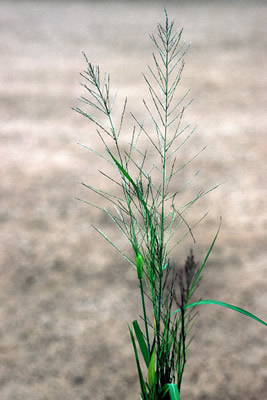Leptochloa chinensis

Latin name
Leptochloa chinensis (L.) Nees
Family
Poaceae
Common name
Red sprangletop
Synonyms
Poa chinensis L. (basionym), P. chinensis Burm. f., P. malabarica Retz., P. sinensis J. F. Gmel.
Geographical distribution
Asia: Japan and Korea.
South and Southeast Asia: Bangladesh, Cambodia, India, Indonesia, Lao PDR, Malaysia, Myanmar, Pakistan, Philippines, Sri Lanka, Thailand, and Vietnam.
Rest of the world: Australia, Papua New Guinea, Swaziland, and West Africa.
Morphology
A tufted and smooth annual or perennial; up to 120 cm tall.
Stem: slender, hollow, erect or ascending from a branching base, rooting at lower nodes, smooth and without hair, typically 10−20 nodes, and can reach as high as 50−100 cm.
Leaf: smooth, linear, 10−30 cm long; ligule an inconspicuous membrane 1−2 mm long and deeply divided into hairlike segments.
Inflorescence: narrowly ovate, loose panicle, main axis 10−40 cm long, and with many spike-like slender branches; racemes slender, each with two rows of spikelets, spikelets 2−3.2 mm long, purplish or green and 4−6 flowered.
Biology and ecology
Red sprangletop propagates by seeds or vegetatively by rootstocks. Germination does not occur when seeds are submerged in water.
Agricultural importance
Leptochola chinensis is a serious weed of rice. Its ability to withstand waterlogged conditions as well as drained, moist conditions makes it a problem weed in rice.
The weed is an alternate host of Cicadulina bipunctata (Melichar), Cnaphalocrocis medinalis (Guenee), Creatonotus gangis Linnaeus, Marasmia spp., Nephotettix spp., Peregrinus maidis (Ashmead), Pseudococcus saccharicola Takahashi, Spodoptera mauritia acronyctoides (Guenee), and nematodes such as Hirschmanniella sp. and Meloidogyne sp. It is also an alternate host of diseases caused by Ephelis oryzae, Pyricularia oryzae, and Rhizoctonia solani.
Leptochola chinensis is used as feed for animals. Its grains serve as a famine food in East Africa.
Management
Cultural control: rotovating and puddling of rice fields during land preparation; hand weeding can be effective during the early growth stages of the weed.
Chemical control: Quinclorac, propanil, pendimethalin, fenoxaprop, pretilachlor, or benthiocarb.
Selected references
- Galinato MI, Moody K, Piggin CM. 1999. Upland rice weeds of South and Southeast Asia. Manila (Philippines): International Rice Research Institute. l56 p.
- Gapasin RM, Barsolete EB, Lim JL. 1996. Survey and identification of plant parasitic nematodes associated with upland weeds and weed response to the rice root-knot nematode, Meloidogyne graminicola. Philipp. J. Weed Sci. 21:22-31.
- Gressel J, Baltazar AM. 1996. Herbicide resistance in rice: status, causes and prevention. In: Auld BA, Kim KU, editors. Weed management in rice. FAO Plant Production and Protection Paper No. 139. Rome (Italy): FAO. p 195-238.
- Hsu C. 1978. Gramineae (Poaceae). Flora of Taiwan. 5:373-783.
- Mew TW, Fabellar NG, Elazegui FA. 1980. Ecology of the rice sheath blight pathogen: parasitic survival. Int. Rice Res. Newsl. 5:16.
- Moody K. 1981. Major weeds of rice in South and Southeast Asia. Manila (Philippines): International Rice Research Institute. 79 p.
- Moody K. 1989. Weeds reported in rice in South and Southeast Asia. Manila (Philippines): International Rice Research Institute. 442 p.
- Moody K, Munroe CE, Lubigan RT, Paller Jr. EC. 1984. Major weeds of the Philippines. Weed Science Society of the Philippines. College, Laguna (Philippines): University of the Philippines at Los Baños. 328 p.
- Pancho JV, Obien SR. 1995. Manual of ricefield weeds in the Philippines. Muñoz, Nueva Ecija (Philippines): Philippine Rice Research Institute. 543 p.
- Soerjani M, Kostermans AJGH, Tjitrosoepomo G. 1987. Weeds of rice in Indonesia. Jakarta (Indonesia): Balai Pustaka. 716 p.







